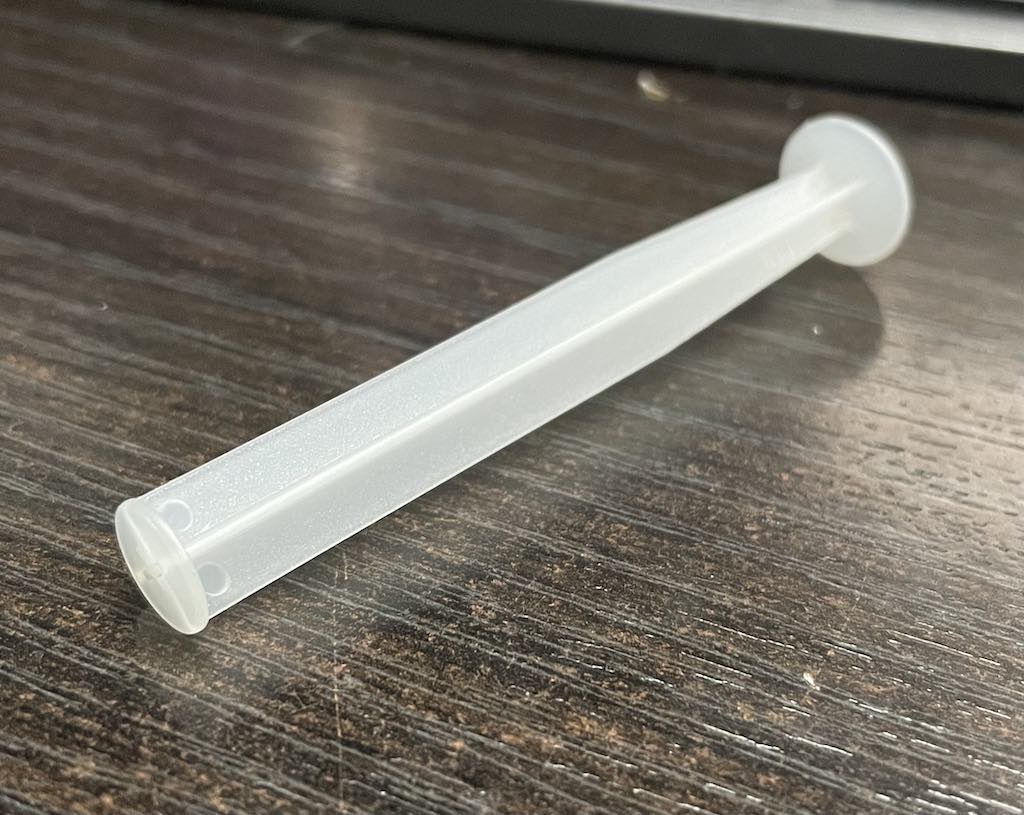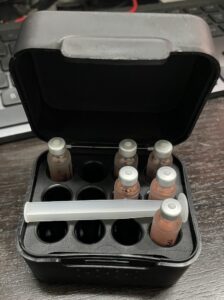I’ve mentioned before that I often fill my pump reservoirs from insulin pen cartridges. They’re a convenient and compact size, plus they can be dropped into pens for emergency backup use.
 It makes for a quick and convenient fill process, where instead of “sucking” insulin out of a vial, I “push” the insulin down into the reservoir, push any air bubbles back up, and push the insulin down. There’s no need to (and in fact sometimes a bad move to) inject air before withdrawing insulin (as we do with vials). But pushing the pen cartridge plunger downwards needs something both thin and long enough to reach.
It makes for a quick and convenient fill process, where instead of “sucking” insulin out of a vial, I “push” the insulin down into the reservoir, push any air bubbles back up, and push the insulin down. There’s no need to (and in fact sometimes a bad move to) inject air before withdrawing insulin (as we do with vials). But pushing the pen cartridge plunger downwards needs something both thin and long enough to reach.
I sometimes use a pencil (as shown in my 2021 “Pump refill kits” article). Sometimes I’ve used a car key (although it’s not long enough to reach all the way to the bottom. Sometimes a screwdriver (as shown in this photo). Sometimes the arm of my glasses (although this can make it harder to see the details of bubbles). A have a thin ballpoint pen that’s sometimes on hand.
But following on from a comment from a fellow looper who made something out of the syringe in an Omnipod kit, I’ve now added a new “gadget” to my kit. Unlike some of my kit, it’s very low-tech!
Hardly a gadget
I grabbed a 3mL syringe off the shelf (last seen in this blog in “Filling an Omnipod“), pulled the plunger out, and cut the rubber tip off with a craft knife.

The result is a simple plastic stick, which happens to be perfectly sized for the job of pushing insulin out of a pen cartridge. The flat end doesn’t dig or cut into the rubber plunger in the cartridge.

The plastic is very light, which makes me happy when packing for a trip. I’m not quite at the level of someone investing in a titanium spork for a camping trip. But when flying with lots of camera, diabetes, and computer gear, every gram adds up.

As you can see, it perfectly suits the size of a Novo Penfill cartridge. It also neatly fits Humalog and Apidra cartridges.

And just so I don’t lose track of this “very special” device, it happens to fit neatly into the Ypsomed carrier box I use for filled PumpCart reservoirs. I never fill the box completely: every few weeks I usually convert three pen cartridges into 5 PumpCarts.
It’s OK to use “stone age” tools in conjunction with our high-tech tools: it’s how neatly the overall system works for us which is important.

I have used pen cartridges to fill pump reservoirs ever since I started pumping in 2004. My main motivation was/is that the PBS prescription price for 5 boxes of 5x3mL (75mL) cartridges is the same as for 5 x 10mL (50mL) vials – that’s 50% more insulin for the same price. The other advantage is that you can fill a 3mL cartridge with a single “push” rather than several transfers from a vial via syringe (along with air injections).
My go-to to push down the cartridge plunger is either a chopstick or a capped syringe; although, sometimes it’s a pen, pencil, screwdriver, etc. I use the Medtronic Paradigm reservoirs, which have a plunder attachement so that you can use them to “suck”from the reservoir rather than push from the cartridge end. This has one advantage in that the partial vacuum created draws some of the dissolved air out of the insulin solution, which can be expelled before you connect the tubing tot he reservoir. I’m not sure whether there is the same effect when using vials as you usually need to pre-inject air so there is an overpressure, not a partial vacuum. By pushing the insulin through, the air remains dissolved and can come out of solution later, forming an air bubble in the reservoir over time. If the air bubble is big enough, it can absorb enough of the compression in the reservoir from the pump plunder that the accuracy of the delivery volume might suffer (not to mention the issues if the air gets into the tubing). Nevertheless, for ease of use, I usually use the push method but I am careful to make sure that I expel all air fromt he reservoir to minimise the size of any air bubble that may form subsequently.
I’ve also found the prefilled pens to be handy, especially if you use the blue coupler that comes with each Medtronic reservoir as it has a nice big bore, making for fast transfers; just connect the “vial” end to the pen and the reservoir end to the reservoir, wind out the dial on the pen to the maximum and push it in a few times (typically 4 or less required).
The disposable pens have a few flaws though, especially if you’re dealing with the Novo FlexTouch pens (such as Fiasp comes in). With that you can’t control the delivery speed (it just pumps it in as fast as the spring will drive it) and this can result in “champagne froth” in the reservoir.
So I both push and pull insulin into my reservoirs as I only replace it and the tubing every second time. In each case I fill the vial with the same amount of air first, pressurizing it before withdrawing the insulin. First time with the reservoir plunger, then the second time with a syringe as I throw out the plunger and dual needle cap after its first use. I haven’t noticed a difference in air bubble amounts between the two methods. I still use a flicking method to get air to the top and a syringe to suck it out in both cases. The syringe has the benefit of being able to precisely put the needle tip just inside the reservoir, whereas the reservoirs accompanying dual needle cap snaps on and can’t be finessed.
Do you think there’s an advantage to leaving a partial vacuum in the vial as far as dissolved air bubbles goes?
Great post. I didn’t realise you could refill Pumpcart with Penfill. Sorry for being dense for not being able to find them, but could you post the link to your instructions on how to do this? Thanks
The transfer adapter for Medtronic/Combo/Ypso reservoirs are sized to clip onto 10 mL vials. You can simply push a Penfill onto there, just be careful to get it centred properly.
It’s harder with Medtronic as the needle in their transfer adapter is usually at a wonky angle. The Combo and Ypso ones are nice and straight.
If filling a syringe for an Omnipod or a t:slim pump you can just stick the syringe needle up into the Penfill.
If using a T-slim with the syringe and needle, connecting 2 of the plastic needle tip covers together also makes for a perfect device foe doing this.
Yes when I used an Animas pump the needle tip cover from it worked for me.